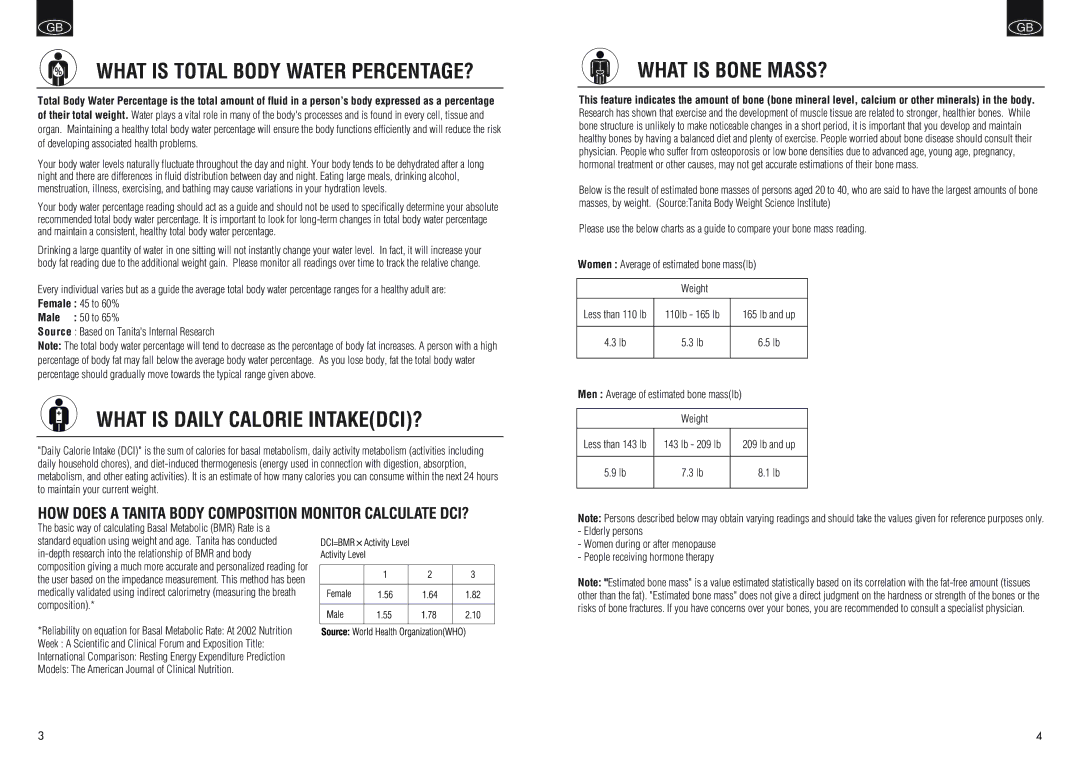
GB
WHAT IS TOTAL BODY WATER PERCENTAGE?
Total Body Water Percentage is the total amount of fluid in a person’s body expressed as a percentage
of their total weight. Water plays a vital role in many of the body's processes and is found in every cell, tissue and organ. Maintaining a healthy total body water percentage will ensure the body functions efficiently and will reduce the risk of developing associated health problems.
Your body water levels naturally fluctuate throughout the day and night. Your body tends to be dehydrated after a long night and there are differences in fluid distribution between day and night. Eating large meals, drinking alcohol, menstruation, illness, exercising, and bathing may cause variations in your hydration levels.
Your body water percentage reading should act as a guide and should not be used to specifically determine your absolute recommended total body water percentage. It is important to look for
Drinking a large quantity of water in one sitting will not instantly change your water level. In fact, it will increase your body fat reading due to the additional weight gain. Please monitor all readings over time to track the relative change.
Every individual varies but as a guide the average total body water percentage ranges for a healthy adult are: Female : 45 to 60%
Male : 50 to 65%
Source : Based on Tanita's Internal Research
Note: The total body water percentage will tend to decrease as the percentage of body fat increases. A person with a high percentage of body fat may fall below the average body water percentage. As you lose body, fat the total body water percentage should gradually move towards the typical range given above.
WHAT IS DAILY CALORIE INTAKE(DCI)?
"Daily Calorie Intake (DCI)" is the sum of calories for basal metabolism, daily activity metabolism (activities including daily household chores), and
HOW DOES A TANITA BODY COMPOSITION MONITOR CALCULATE DCI?
The basic way of calculating Basal Metabolic (BMR) Rate is a standard equation using weight and age. Tanita has conducted
*Reliability on equation for Basal Metabolic Rate: At 2002 Nutrition
Week : A Scientific and Clinical Forum and Exposition Title:
International Comparison: Resting Energy Expenditure Prediction
Models: The American Journal of Clinical Nutrition.
GB
WHAT IS BONE MASS?
This feature indicates the amount of bone (bone mineral level, calcium or other minerals) in the body. Research has shown that exercise and the development of muscle tissue are related to stronger, healthier bones. While bone structure is unlikely to make noticeable changes in a short period, it is important that you develop and maintain healthy bones by having a balanced diet and plenty of exercise. People worried about bone disease should consult their physician. People who suffer from osteoporosis or low bone densities due to advanced age, young age, pregnancy, hormonal treatment or other causes, may not get accurate estimations of their bone mass.
Below is the result of estimated bone masses of persons aged 20 to 40, who are said to have the largest amounts of bone masses, by weight. (Source:Tanita Body Weight Science Institute)
Please use the below charts as a guide to compare your bone mass reading.
Women : Average of estimated bone mass(lb)
Weight
Less than 110 lb | 110lb - 165 lb |
| 165 lb and up | |||
|
|
|
|
|
|
|
4.3 lb | 5.3 lb |
|
|
| 6.5 lb | |
|
|
|
|
|
|
|
|
|
|
|
|
|
|
Men : Average of estimated bone mass(lb) |
|
|
| |||
|
|
|
|
|
|
|
|
| Weight |
|
|
| |
|
|
|
| |||
Less than 143 lb | 143 lb - 209 lb |
| 209 lb and up | |||
|
|
|
|
|
| |
5.9 lb | 7.3 lb |
|
|
| 8.1 lb | |
|
|
|
|
|
|
|
Note: Persons described below may obtain varying readings and should take the values given for reference purposes only.
-Elderly persons
-Women during or after menopause
-People receiving hormone therapy
Note: "Estimated bone mass" is a value estimated statistically based on its correlation with the
3 | 4 |
